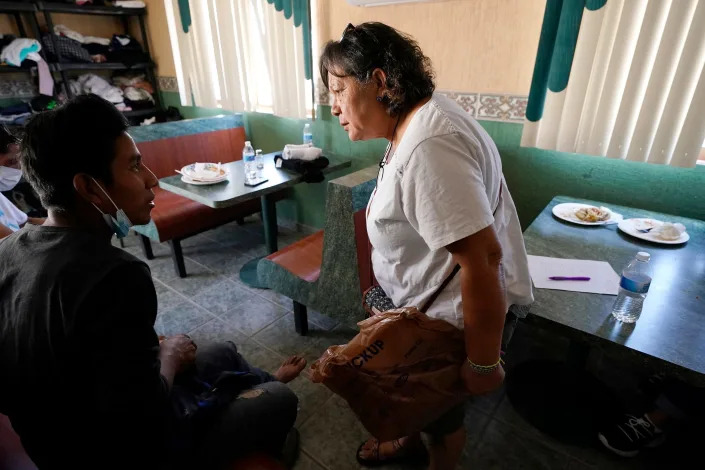Border Patrol's caging of migrants in record heat decried by advocates
José Ignacio Castañeda Perez, Arizona Republic
Tue, July 25, 2023
WHY, ARIZ. — A few dozen migrants sat under the sun and sweltering temperatures that would reach a high of 117 degrees as they were detained Saturday in an outdoor cage at the Ajo Border Patrol Station.
The majority of migrants sat beneath the shade of the large white canopy as others stood beneath the sun. From the observation point, many of the migrants appeared to be men, but it was difficult to discern migrants’ gender.
Migrant advocates and elected officials decried the outdoor caging of migrants, in the heat describing it as “cruel” and “inhumane.”
“I was horrified, but I’m sadly not surprised because this treatment of migrants is nothing new,” said Janice Rosenberg, a volunteer with the Ajo Samaritans humanitarian group.

People are seen congregated in an outdoor shelter outside of the Ajo Border Patrol Station.
The station sets in rugged terrain in the Sonoran Desert, a deadly area that has claimed the lives of thousands of migrants over the past two decades. The discovery of the cage comes during a wave of record-breaking heat across Arizona.
Initial reporting: Ajo Border Patrol detains migrants in outdoor chain-link cage during record heat
Phoenix, about two hours away from the station, has documented 24 continuous days of 110-plus-degree temperatures as of Sunday. The cage composed of chain-link fences was first reported by the Intercept Friday.
Rep. Raúl Grijalva, whose district encompasses the Ajo station and over 350 miles of the U.S.-Mexico border, said the situation borders on cruelty. Grijalva, D-Ariz., contacted the U.S. Department of Homeland Security after he heard the news Friday.

An outdoor shelter sits outside of the Ajo Border Patrol Station.
“It is a critical situation and it is a dangerous situation,” Grijalva said. “I never thought that the detention part of Homeland Security wouldn't understand that we're in Arizona.”
Dora Rodriguez, board chair for the Tucson-based humanitarian organization Humane Borders, described the conditions at the station as “outrageous.”
In 1980, Rodriguez was one of the 13 Salvadorans who survived when another 13 people in the group died after being abandoned by their guide and left to wander near Organ Pipe Cactus National Monument in Arizona. Organ Pipe is only about five miles south of the station.
“It's very painful,” Rodriguez said. “It brings anger; it brings so many mixed emotions on how we are capable of treating our asylum seekers.”

Dora Rodriguez, center, who was among 13 Salvadorans who survived in 1980 when another 13 people in the group died in the broiling sun near Organ Pipe Cactus National Monument, talks with Vicente Lopez, 19, who grew up in Guatemala's Ixil triangle, where government troops in the early 1980s wiped out entire communities suspected of harboring rebels, on Wednesday, May 19, 2021, in Sasabe, Mexico. At the age of 19, she remained in Tucson and eventually became a U.S. citizen.More
Migrants in the cage are provided with large fans, hot meals, waters and bathrooms, according to U.S. Customs and Border Protection. After arriving at the Ajo station, migrants are medically screened and initially processed.
'Recipe for death': Record temps, policies contribute to recent string of migrant deaths
Migrants may then be “rotated to an outside facility” at the station before they are taken to other locations for further processing, according to CBP.
“The U.S. Border Patrol has surged personnel and transportation resources in recent weeks to respond to a significant increase in encounters near Ajo, AZ — some of the hottest, most isolated, and dangerous area of the southwest border — where individuals have been callously sent by smuggling organizations to walk for miles, often with little or no water,” a CBP spokesperson said Friday in a written statement.

People are seen congregated in an outdoor shelter outside of the Ajo Border Patrol Station.
The Tucson Border Patrol Sector has seen a “significant” increase in migrant encounters in recent months, per CBP. Human smuggling organizations are moving migrants through the Cabeza Prieta National Wildlife Refuge and the Organ Pipe Cactus National Monument near Ajo, according to CBP.
The Florence Immigrant & Refugee Rights Project is “horrified” by reports of the outdoor conditions in near-record high temperatures, according to Laura St. John, legal director with the nonprofit. The organization provides free legal and social services to migrants facing detention and potential deportation.
“This treatment is cruel, inhumane, and yet another example of CBP's utter lack of ability or desire to properly care for migrants in its custody,” St. John said in a written statement. “People seeking protection in the U.S. deserve to be welcomed with dignity and treated humanely, not be caged outside in punishing and dangerous heat."
When it’s within CBP control, Border Patrol agents are required to maintain holding room temperature within a “reasonable and comfortable range,” according to CBP’s detention standards.
Additionally, migrants within Border Patrol custody should not be held for longer than 72 hours.
In April, Border Patrol in San Diego kept asylum seekers in between border walls in an open-air encampment for days without food. In March 2021, Border Patrol held migrant families under a bridge for days in Mission, Texas.
This article originally appeared on Arizona Republic: Advocates decry 'inhumane' conditions as Border Patrol cages migrants

No comments:
Post a Comment